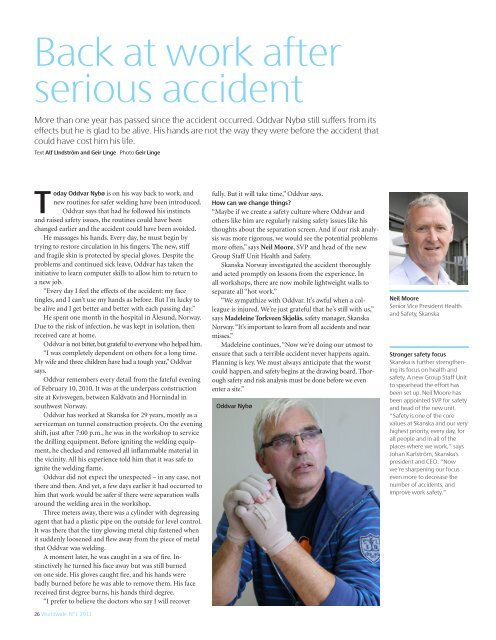Worldwide - Skanska
Worldwide - Skanska
Worldwide - Skanska
Create successful ePaper yourself
Turn your PDF publications into a flip-book with our unique Google optimized e-Paper software.
Back at work after<br />
serious accident<br />
More than one year has passed since the accident occurred. Oddvar Nybø still suffers from its<br />
effects but he is glad to be alive. His hands are not the way they were before the accident that<br />
could have cost him his life.<br />
Text Alf LIndström and Geir Linge Photo Geir Linge<br />
Today Oddvar Nybø is on his way back to work, and<br />
new routines for safer welding have been introduced.<br />
Oddvar says that had he followed his instincts<br />
and raised safety issues, the routines could have been<br />
changed earlier and the accident could have been avoided.<br />
He massages his hands. Every day, he must begin by<br />
trying to restore circulation in his fingers. The new, stiff<br />
and fragile skin is protected by special gloves. Despite the<br />
problems and continued sick leave, Oddvar has taken the<br />
initiative to learn computer skills to allow him to return to<br />
a new job.<br />
“Every day I feel the effects of the accident: my face<br />
tingles, and I can’t use my hands as before. But I’m lucky to<br />
be alive and I get better and better with each passing day.”<br />
He spent one month in the hospital in Ålesund, Norway.<br />
Due to the risk of infection, he was kept in isolation, then<br />
received care at home.<br />
Oddvar is not bitter, but grateful to everyone who helped him.<br />
“I was completely dependent on others for a long time.<br />
My wife and three children have had a tough year,” Oddvar<br />
says.<br />
Oddvar remembers every detail from the fateful evening<br />
of February 10, 2010. It was at the underpass construction<br />
site at Kvivsvegen, between Kaldvatn and Hornindal in<br />
southwest Norway.<br />
Oddvar has worked at <strong>Skanska</strong> for 29 years, mostly as a<br />
serviceman on tunnel construction projects. On the evening<br />
shift, just after 7:00 p.m., he was in the workshop to service<br />
the drilling equipment. Before igniting the welding equipment,<br />
he checked and removed all inflammable material in<br />
the vicinity. All his experience told him that it was safe to<br />
ignite the welding flame.<br />
Oddvar did not expect the unexpected – in any case, not<br />
there and then. And yet, a few days earlier it had occurred to<br />
him that work would be safer if there were separation walls<br />
around the welding area in the workshop.<br />
Three meters away, there was a cylinder with degreasing<br />
agent that had a plastic pipe on the outside for level control.<br />
It was there that the tiny glowing metal chip fastened when<br />
it suddenly loosened and flew away from the piece of metal<br />
that Oddvar was welding.<br />
A moment later, he was caught in a sea of fire. Instinctively<br />
he turned his face away but was still burned<br />
on one side. His gloves caught fire, and his hands were<br />
badly burned before he was able to remove them. His face<br />
received first degree burns, his hands third degree.<br />
“I prefer to believe the doctors who say I will recover<br />
26 <strong>Worldwide</strong> N°1 2011<br />
fully. But it will take time,” Oddvar says.<br />
How can we change things<br />
“Maybe if we create a safety culture where Oddvar and<br />
others like him are regularly raising safety issues like his<br />
thoughts about the separation screen. And if our risk analysis<br />
was more rigorous, we would see the potential problems<br />
more often,” says Neil Moore, SVP and head of the new<br />
Group Staff Unit Health and Safety.<br />
<strong>Skanska</strong> Norway investigated the accident thoroughly<br />
and acted promptly on lessons from the experience. In<br />
all workshops, there are now mobile lightweight walls to<br />
separate all “hot work.”<br />
“We sympathize with Oddvar. It’s awful when a colleague<br />
is injured. We’re just grateful that he’s still with us,”<br />
says Madeleine Torkveen Skjølås, safety manager, <strong>Skanska</strong><br />
Norway. “It’s important to learn from all accidents and near<br />
misses.”<br />
Madeleine continues, “Now we’re doing our utmost to<br />
ensure that such a terrible accident never happens again.<br />
Planning is key. We must always anticipate that the worst<br />
could happen, and safety begins at the drawing board. Thorough<br />
safety and risk analysis must be done before we even<br />
enter a site.”<br />
Oddvar Nybø<br />
Neil Moore<br />
Senior Vice President Health<br />
and Safety, <strong>Skanska</strong><br />
Stronger safety focus<br />
<strong>Skanska</strong> is further strengthening<br />
its focus on health and<br />
safety. A new Group Staff Unit<br />
to spearhead the effort has<br />
been set up. Neil Moore has<br />
been appointed SVP for safety<br />
and head of the new unit.<br />
“Safety is one of the core<br />
values at <strong>Skanska</strong> and our very<br />
highest priority, every day, for<br />
all people and in all of the<br />
places where we work,” says<br />
Johan Karlström, <strong>Skanska</strong>’s<br />
president and CEO. “Now<br />
we’re sharpening our focus<br />
even more to decrease the<br />
number of accidents, and<br />
improve work safety.”

















